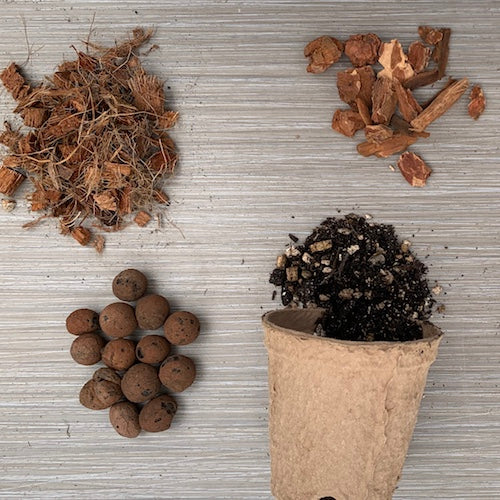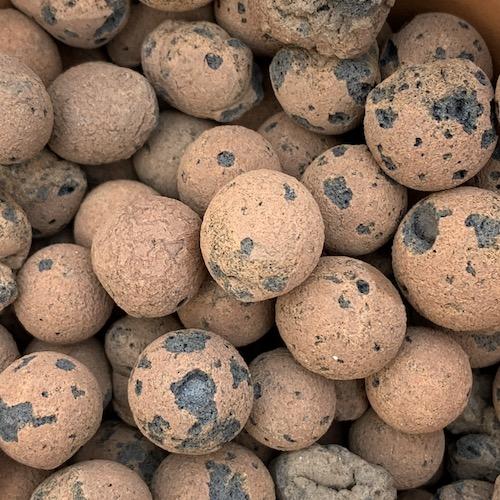Anyone who has gardened over the last thirty years has gotten used to the ubiquity of standardized peat potting mixes. Peat became dominant for both commercial and home gardeners for several reasons, namely, peat is cheap, easily handled and readily available. However, peat potting soils also have many disadvantages. For example, peat is not great at holding water, the fibres break down quickly and of course, there is considerable discussion about the non-sustainable nature of disturbing (large release of CO2) and harvesting peat (takes 1,000,000 years to replenish). Furthermore, most peat-based potting mixes are generic and do not cater to specific plants' needs.
One of the other consequences of the proliferation of peat-based potting soils has been the trend away from creating one's own soil mixes; in moving away from custom mixes gardeners of all types have lost appreciation for the power of soil and understanding how different soil ingredients help support growth for various types of plants (of course, many gardeners are rediscovering the value of "dirt"... but at one time all gardeners needed to know something of how soil supported plant growth).
But exciting things are happening! The surge in popularity of houseplants has revealed a huge new demographic of gardeners who want to know exactly what the best soil options are for their plants, and across demographics, there are ever louder calls for action to replace peat in horticulture. In fact, the United States and the UK both have mandates to ban peat moss from horticulture within the next few years. That is amazing, as this kind of leadership is the only way true alternatives are going to come to the mass market and fill in the gaps (for example, we have yet to find an effective non-peat seed starting mix for spring propagation, but we know there is a solution out there).
In the meantime, I wanted to share a couple of simple soil alternatives that many people are using right now. Several of these are particularly popular with houseplant enthusiasts, but simply being aware that there are alternatives opens up lots of opportunities to grow better plants, more easily and with increasingly sustainable growing media.

Coco coir is one of the most popular peat alternatives, as the fine-textured types of coir feel quite similar to peat and can be used for many of the same purposes. Coir is made from coconut husks, so it comes from a fully renewable resource but is sometimes flagged for having to be shipped a long distance from its place of origin (albeit rather efficiently in super-compressed bricks).
Advantages of coir over peat include: coir fibres are long and break down much less quickly vs. peat, plus coir is very good at holding water and then slow-releasing as the medium dries out. At Sage Garden, we have found coir to be an excellent alternative to peat for houseplants (some, not all), plus veggie, herb and bedding plants. In fact, this is the peat alternative that has allowed us to start the switch to peat-free production at the greenhouse. Where coir has not served us well is for seed starting; the water-holding capacity is too high and the soil gets heavy, with a clearly negative impact on germination and seedling development. We have found adding lots of coarse vermiculite helps, and we use a coir/vermiculite/Sea Soil mix for starting indoor leafy greens (Wintergreens).
While finely textured coco-coir is a realistic option for potting mix, the chunkier coir chips are also useful for growing. The large particle size of coir chips makes them an excellent base for many houseplants (particularly aroids), which require both exceptional drainage and aeration with some water holding capacity.

Orchid bark is another popular medium among houseplant growers. This material is most commonly made from pine or fir bark, which is very durable, chunky and useful for not only orchids but many epiphytes and other plants requiring a free-draining mix. Although orchid bark can be used stand-alone for some plants, it is also a useful ingredient in custom mixes (e.g. for some types of bonsai or tropical container fruits).

Horticultural charcoal is perhaps a surprising natural ingredient, often added to houseplant and terrarium mixes to reduce the occurrence of root rot.

LiaFlor, also known as LECA (Lightweight Expanded Clay Aggregate) is perhaps the most un-soil-like item on this list. This material is used extensively in hydroponics, but. also as a popular substrate for growing aroids. The clay pellets are excellent at creating air spaces while also holding moisture in the many small cavities within each pellet. LiaFlor basically never breaks down and can be reused indefinitely. Clay pellets are used mixed with more traditional soil ingredients, both for indoor and outdoor potted plants, adding excellent aeration and water holding capacity to the soil. I could see this being a fantastic addition to herb mixes for potted lavender & rosemary, which appreciate very coarse soils.

Hope this inspires some exploration of materials that can be used to create both specialized and general soil mixes as we move towards a post-peat gardening world.
~ Dave








